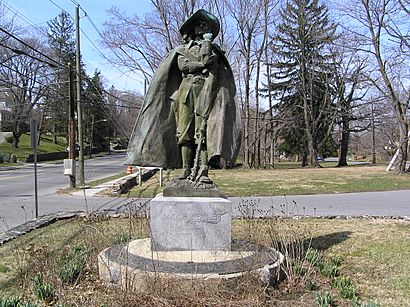Statue of Jacob Leisler facts for kids
The Jacob Leisler Monument is a bronze statue in New Rochelle, New York. It was made by the American artist Solon Borglum. This monument honors Jacob Leisler, an important figure from the 1600s.
Leisler was known for supporting the Huguenot settlers. He is also remembered as the first leader of New York province who got his power directly from the people. The statue was officially revealed on June 24, 1913. This event was a big part of celebrating New Rochelle's 250th birthday. This monument is the only statue of Jacob Leisler that exists today.
Contents
Who Was Jacob Leisler?
Jacob Leisler was born in Germany. He came to North America in 1660 as a soldier. He worked for the Dutch West India Company.
Leisler's Journey to Power
Leisler settled in New Amsterdam, which is now New York City. He left the company and became a very successful merchant. He traded tobacco and furs, which made him wealthy. He also held several public jobs, like justice of the peace and judge.
In 1689, a big change happened in England. New rulers, William III and Mary II, took the throne. This led to a period of unrest in New York. Leisler led a movement called Leisler's Rebellion. He had a lot of support from regular people.
He took control of the city and colony. He became the acting leader of New York province. He held this position until the new governor, appointed by William and Mary, arrived in March 1691. During this time, Leisler bought land. He set aside some of it to help create the Huguenot settlement of New Rochelle in 1689.
A Difficult End and Clearing His Name
In 1691, Leisler was arrested. He was put on trial by people who were his political rivals. The charge was for not giving up power to the new lieutenant governor right away. He and his son-in-law were both executed. Many people at the time felt that the trial was unfair.
However, four years later, the government in England reviewed his case. They officially cleared Leisler's name. His family got his property back. This action showed that he was innocent and honored his support for the Huguenots.
About the Statue
There are no known pictures of Jacob Leisler from his time. So, the statue shows a general male figure. This figure is dressed in clothes from the 1600s.
What Does the Statue Look Like?
The statue shows a man wearing a long cape, knee breeches, boots, and a hat. He holds a walking stick in his right hand. His left arm rests on top of the stick.
The bronze statue stands on a square stone base. This base sits on a round concrete foundation. The statue itself is about 9 feet tall, 5 feet wide, and 3 feet deep. The stone base is about 4 feet 30 inches by 4 feet 30 inches. The round foundation is about 1 foot tall and 10 feet across.
Messages on the Monument
The monument has several important messages carved into it.
HUGUENOT CHAPTER, DAUGHTERS OF THE REVOLUTION, STATE OF NEW YORK AND THE HUGUENOT ASSOCIATION OF NEW ROCHELLE
DEDICATED JUNE 25, 1913

